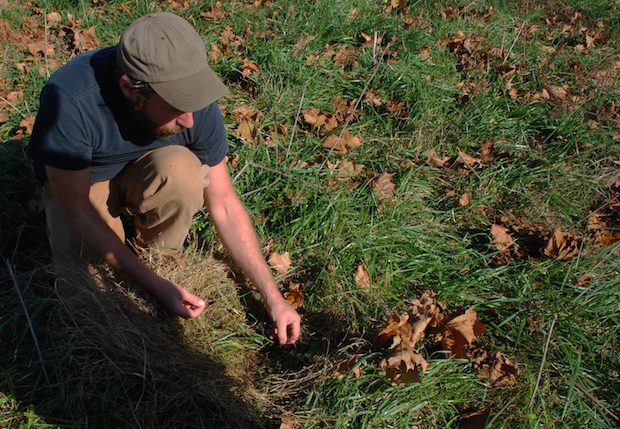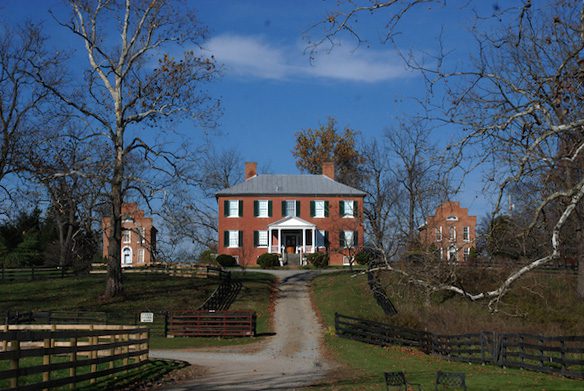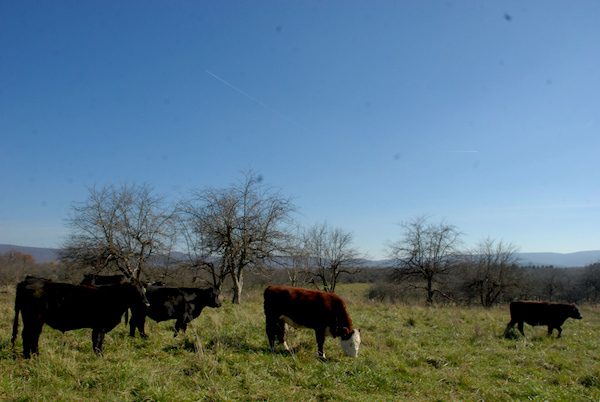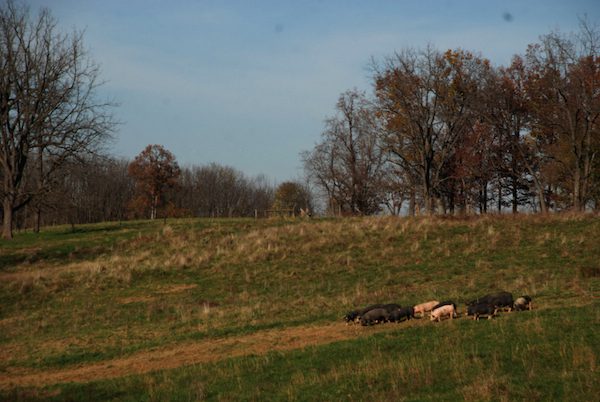Bringing Back Husbandry

America’s agrarian culture is suffering. Today’s average farmer or rancher is 58 years old, and on the verge of retirement. Whereas in 1840, almost 70 percent of our labor force worked in agriculture, a mere two percent were doing so in 2000. Most farm operators depend on outside income in order to survive—and “In just five years,” notes Vox, “The US experienced a net loss of 90,000 farms.”
Yet Forrest Pritchard—owner of Smith Meadows Farm and author of Gaining Ground: A Story of Farmers’ Markets, Local Food, and Saving the Family Farm—says “there’s never been a better time to get into farming.” Pritchard published Gaining Ground last year, and has already garnered considerable acclaim in the agrarian community. Modern Farmer profiled his book in July 2013. He now travels regularly, speaking at conferences and talking about his farm.
Gaining Ground presented a different face to the sustainable farming movement: Smith Meadows Farm has been in Pritchard’s family for seven generations, but was steadily losing money. “In 1996, I returned from college to my family’s farm and found it in complete shambles,” he writes. “My parents had given up on ever making a profit from farming, and had taken jobs in the city to make ends meet. …The land didn’t generate enough profit for us to even buy our own food. Our family farm, just like thousands of others across the country, was undeniably broken.”
Pritchard’s book isn’t really a story of entrepreneurial innovation (like Joel Salatin’s works), nor is it representative of the boutique farming that has recently come into vogue. His story is one of renewal, of bringing a dying family farm back to life.
After parking by the farm store, Pritchard greets me with a firm handshake and begins his tour of the farm. Pritchard is a meat farmer, and regularly rotates cattle, pigs, goats, sheep, chickens, and turkeys to fresh paddocks of grass. The livestock are never fed animal by-products or given growth hormones or antibiotics.
While we walk over to where the cows are pasturing, I ask Pritchard if he ever intends to expand his enterprise—to grow produce, say, or to sell dairy products. He would rather focus on being a meat farmer, he says. It’s not just that he can barter and trade for all the produce he needs at weekend farmer’s markets; he also wants to keep improving the quality of his current enterprise. “You can spend your entire life just focusing on raising one breed of cattle,” he notes.
While the farm has grown considerably over time, Pritchard says he’s learned to say no—to limit his farm to what it’s capable of producing, and to not stretch himself (or his land) too far. While many farmers have felt pressure to specialize and industrialize their productions in order to turn a profit, Pritchard takes a longer view—noting that, at his current size and productivity levels, he has built a successful customer base, is garnering a profit, and is still keeping his land healthy.
Pritchard then reminds me of the difference in the air. I realize that, surrounded by animals usually associated with pungent odors of excrement, I can barely smell their presence. This, Pritchard notes, is one of the most noticeable differences between grass-fed livestock and their industrially-farmed counterparts. Livestock who are out grazing all day don’t leave the same pungent odors. On this farm, all you can smell is fresh air and grass.
Pritchard believes industrialized methods have changed more than just the smell of a farm, however. They have also had a markedly deleterious impact on the next generation of agrarians. For 50 to 60 years, Pritchard says, “we’ve done a great job of creating inexpensive food abundance, and decreasing quality of life and satisfaction [for farmers and their families].” Kids who grew up beside “manure lagoons and spray houses,” who saw their parents scraping to get by, barely turning a profit, have no desire to inherit such an enterprise. “Who wants to sign up for that?” Pritchard asks.
In order to save his family farm, Pritchard has worked hard to “make a normal business structure, where you get a return on business. You gotta make a profit.” Pritchard also notes that he’s careful not to put too much pressure on his son, who is still quite young, to follow in his footsteps. “A childhood is an important thing to have,” he says. “I don’t want him to feel forced from a young age.” Pritchard himself remembers having a delightful childhood on this very farm, having the ability to roam and explore even amidst chores and schoolwork. He wants to make sure his son has the same experiences, so that he will associate this farm with joy and love, not merely drudgery and duty. This balance of involvement and freedom, exploration and responsibility, “creates a deep impact.”
After his tour of the chickens and turkeys, Pritchard shows me the pigs, grazing in the back area of the property. As the pigs nibble at my boots, Pritchard tells me that an apprentice once bemoaned the harmful effect they seemed to have on the land. Their fierce appetites turn all green things into piles of mud. But appearances are deceiving: once the pigs have moved on and the soil has rested, plants grow back more lush than ever.
Pritchard crouches down in the dirt and pushes away a clump of trampled sod with his hands. “Not all patches of land are as perfect as this,” he says, “but this is what we’re aiming for.” Beneath the sod—a natural covering of trampled grass, due to the activity of animals on the property—are loose, lush clumps of earth. The soil is black and moist, and even in November, sprouts of new grass are pushing up out of the ground. “This is new life,” Pritchard says. It just takes time to see it.
Pritchard considers himself a soil farmer as much as a meat farmer. As the title of his book suggests, Smith Meadows farm really is an enterprise focused on “gaining ground,” replenishing and renewing earth that has suffered for centuries, due to chemicals and overwork. With time and careful diligence, Pritchard is trying to reverse the soil depletion of generations past. And he gets as excited about this as he does the beef and chickens that roam the property.
There’s a beautiful longevity to this fixation on the soil. Unlike the consumeristic approach of many farmers, who steadily deplete the health of the soil through overwork and undernourishment, Pritchard is adamant about maintaining the health of the dirt itself. Of course it makes sense that tending the soil will eventually result in a myriad of benefits for Pritchard. His livestock will continue to have lush grass, which will in turn result in their health and future profitability.
But Pritchard is also dedicated to a generational view of farming, and wants this farm to reach its eighth generation of stewardship. It is exactly this sort of generational methodology that encourages farmers to seek the good of their ground, no matter the short-term challenges or difficulties. If a certain piece of property needs to “rest” for several months (as property grazed by pigs must), Pritchard sets it aside readily. He is looking to the future, and knows that rest is a necessary gift, to the land and to himself.
As Pritchard put it in his interview with Modern Farmer,
I think there’s probably a bit of a difference between a first-generation person who is very interested in wanting to farm maybe for philosophical reasons, or maybe because they think it’s a sound business decision and farmers who have been born into the land and have been surrounded by fields and forests and streams and all these things. You have a real sense of stewardship that becomes a multi-generational perspective if it’s not about one farmer. It’s about the generation before and the generation that comes afterwards.
Wendell Berry has pointed this out in countless essays: to him, it illustrates an important difference between modern farming and the classical concept of “husbandry.” Husbandry is about a more loving, devoted, selfless care than most modern farmers exhibit. It’s about cultivating a holistic health, in soil and land, that transcends profit. “Husbandry,” writes Berry, “is the name of all the practices that sustain life by connecting us conservingly to our places and our world; it is the art of keeping tied all the strands in the living network that sustains us.” (“Renewing Husbandry,” 2004.) By making agriculture into a science and an industry, rather than a domestic and familial vocation, we have lost an appreciation for holistic flourishing. “The modern farm is understood as a surface on which various mechanical operations are performed, and to which various chemicals are applied,” writes Berry. “The under-surface reality of organisms and roots is mostly ignored.”
But soil husbandry, that appreciation of the land which includes conscientious care for its earth, leads to true health. As Berry writes in his 2006 essay, “On the Soil and Health,” “The soil has living creatures in it. It has live roots in it, perennial roots if it is lucky. If it is the soil of the right kind of farm, it has a farm family growing out of it.”
Pritchard finishes his tour of the farm, and we head back to the farm store. The store works entirely on an honor system: people grab the products they want from the meat freezer, and then put their payment in a money box before they leave.
We sit on the front porch, and Pritchard talks about his hopes for the future. Though he wasn’t originally interested in outreach, he now sees speaking and writing as his “way of giving back.”
“Every farmer is deeply interested in holding onto their farm,” he says. Their biggest challenge is “getting on board with the changing narrative of their story.” As consumers seek out more organic, sustainably farmed products, some farmers are hesitant to absorb the practices, seeing them as merely “trendy.”
But Pritchard combats this idea with a vehemence. He believes that organic, sustainable farming isn’t trendy, “it’s ancient, multi-generational, and multi-ethnic.” Indeed, he’s written a new book on the subject, which will be released in September 2015. In it, Pritchard interviews 18 different farmers from around the U.S., sharing their stories and recipes.
Pritchard hopes this book will reach the next generation of farmers. “I’m worried about the 20-year-olds,” he says. Though many young up-and-coming farmers are enthusiastic about organic methodologies, they aren’t fluent in the business know-how necessary to maintain a farm. “You gotta combine sustainability with economics,” Pritchard says. “You gotta make a profit.”
But Pritchard sees the new opportunities provided by social media and burgeoning farmer’s markets. He sees the rise of CSA’s (community-supported agriculture), Whole Foods, and even some middle-man companies (like From the Farmer DC), helping connect consumers with local farms. He sees the popularity of the locavore movement, and his own eager base of customers. And he tells me that farmers today have a “colossal opportunity” to succeed. Having “lived both sides of it,” Pritchard sees a bright future for Smith Meadows Farm—and for sustainable agriculture.
Gracy Olmstead is an associate editor at The American Conservative.



Comments